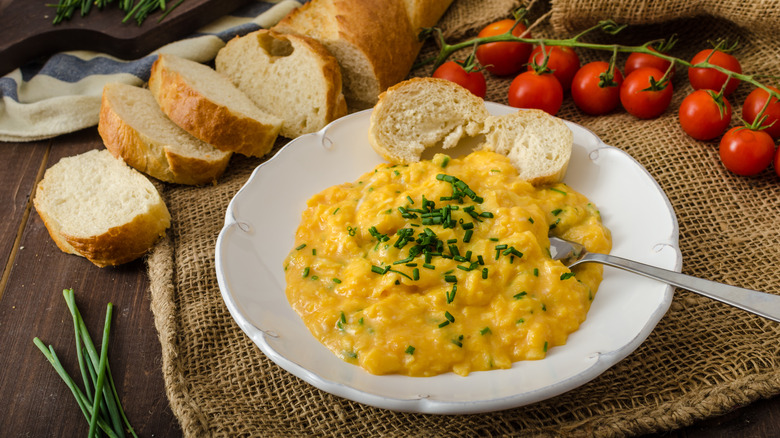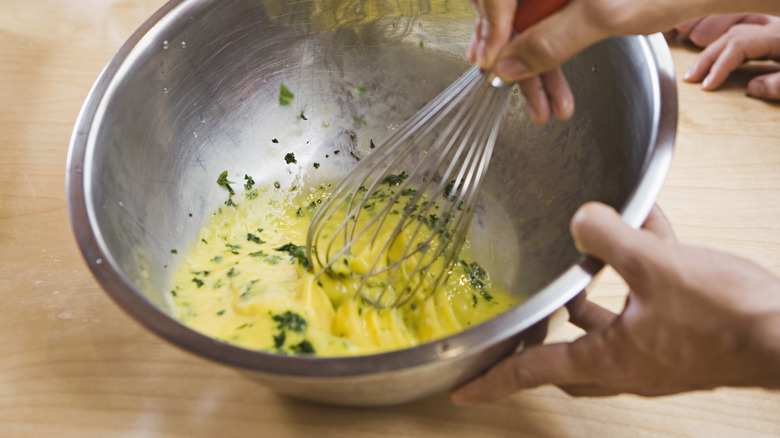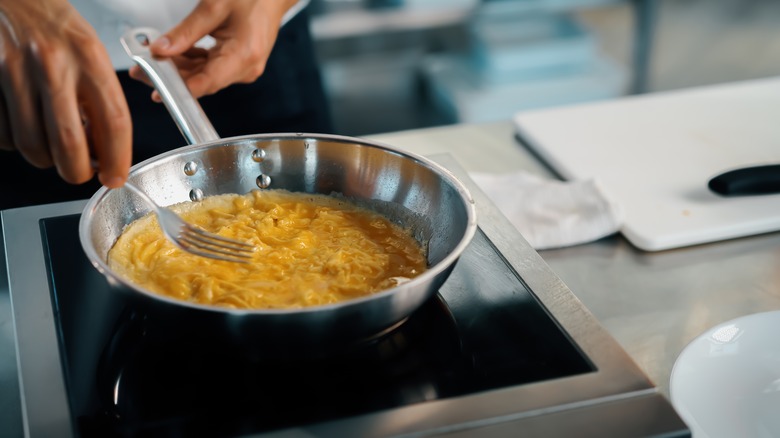The Clever Sieve Hack That Makes Scrambled Eggs Extra Delicate
Some dishes require a great deal of time, effort, and ingredients in order to yield delicious results, but scrambled eggs aren't one of them. Though people often add cheese and butter, all you really need is eggs. And unless you consider pushing eggs around a pan to be a special culinary technique, there's not much skill involved in making the breakfast either. Depending on certain factors, however, the resulting texture of the scramble can vary.
American-style scrambled eggs, for example, tend to have larger, more well-done curds. The eggs are typically cracked right into the pan and scrambled whole instead of beaten separately. English scrambled eggs, by contrast, are beaten before they're added to the pan. They're also taken off the heat earlier to finish cooking through residual heat. The French method creates the most delicate scramble of all, characterized by fine curds and an ultra-creamy consistency. If this type of scrambled eggs appeals to you, you'll want to make sure you have a sieve on hand next time you make breakfast.
What happens when you make scrambled eggs with a sieve?
A fine strainer or sieve probably isn't the first thing you reach for when making scrambled eggs, though it is a common tool when making poached eggs. For poached eggs, you'd crack an egg into a strainer to remove the runny part of the white and ultimately give it a perfectly rounded edge. When it comes to scrambled eggs on the other hand, the reason you'd run them through a sieve is a bit different.
What gives American-style scrambled eggs their large, firm curds is primarily the lack of beating involved. Because the albumen isn't completely broken down or combined with the yolks, it cooks at a faster rate than the yolks, resulting in a firmer overall scramble. The opposite occurs when the whites and yolks are fully homogenized. This can be achieved simply by whisking the eggs in a bowl for at least 30 seconds, but straining them prior to cooking on top of that is an easy way to ensure you end up with the most delicate curds possible.
Temperature is also important for delicate scrambled eggs
If your pan is too hot, unfortunately it won't really matter how well you strain your eggs because they'll cook before you get the chance to scramble them. The best way to go about it is to use low heat, and constantly stir the sieved eggs around. A regular spatula will do, but for even finer curds, use a pair of chopsticks. The constant stirring and the low temperature will prevent the eggs from getting too much direct contact with the heat, and thus a lighter, creamier scramble with smaller curds will form.
For even more control over the texture of your scrambled eggs, take the pan on and off the stove as you stir. As Julia Child wrote in the first volume of "Mastering the Art of French Cooking," this process will create the most custard-like consistency. She also recommended finishing it with a knob of butter to bring the temperature of the eggs down and bring the cooking process to a halt. Combine Child's techniques with the sieve hack, and your scrambled eggs will always turn out extra delicate.


